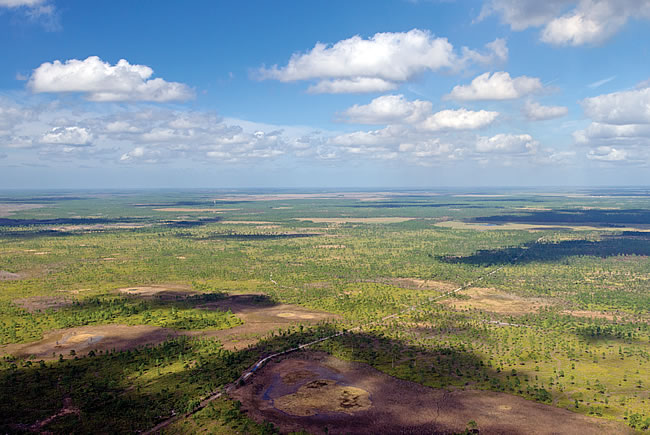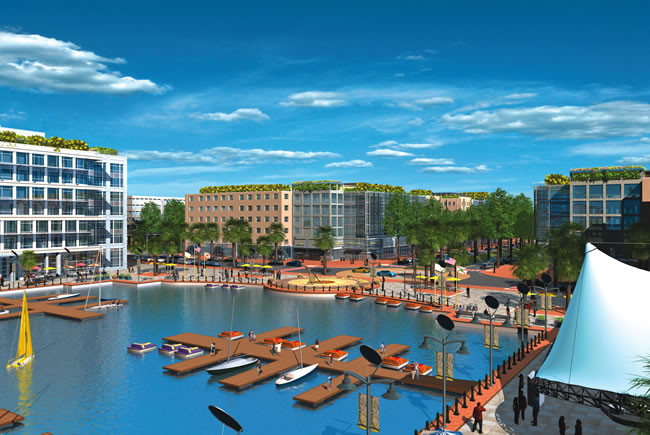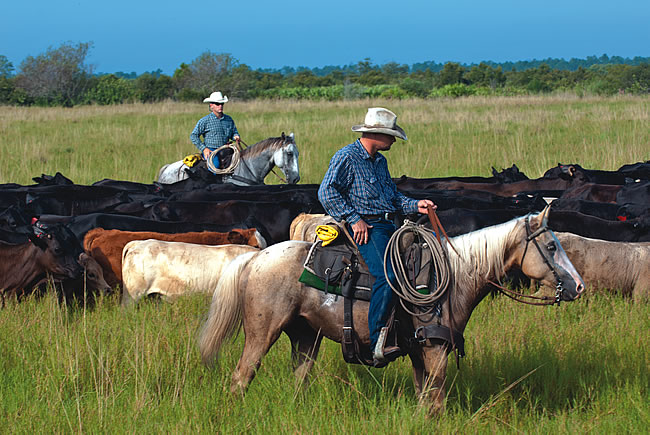SHARE:
Green Development
Meanwhile, back at Babcock Ranch...
Developer Syd Kitson wanted to create the greenest city on earth on a southwest Florida cattle ranch. Six years later, his survival shows the importance of another kind of green.
From under the crossed-horns arch over the front gate, a long road runs by waterlogged pastures deep into Babcock Ranch. Down a turnoff is a lakeside lodge. Outside, sunning itself on a peninsula, rests an alligator as black as the water around it. Inside the lodge sits Syd Kitson, a forward-thinking guy who has found the way ahead longer and bumpier than he had envisioned.
— Syd Kitson
In 2006, Kitson made national news with his bold purchase of Babcock, a 142-square-mile, 91,000-acre cattle ranch in Charlotte and Lee counties in southwest Florida. The ranch was an environmental showpiece, maintained with care by Babcocks since its acquisition in 1914 by lumber industrialist and Pittsburgh Mayor Edward Vose Babcock. Kitson instantly fulfilled the dreams of environmentalists by selling the state 73,000 acres. The sale was the state’s largest land preservation deal.
For the remaining 17,800 acres, Kitson had a grand plan. He would keep nearly half the acreage as green space and parks. That meant that of the original 91,000 acres, only 10% or so would be developed. On that tenth, he envisioned a green city of 50,000 residents living in 19,500 homes built to energy-conservation standards and 20,000 workers in 6 million square feet of energy-efficient buildings. People could walk out of their doors and onto 30 to 40 miles of walking trails. They would get around on autonomous electric vehicles. “How many people get to build a new city?” Kitson told the New York Times in 2006. “This is how I’m going to change the world.”
Six years later, the new city remains pasture. “I discovered why so few people have created cities,” he says.
Kitson’s road to developer of the “world’s smartest city” — as company materials put it — started in his native New Jersey, wound through Wake Forest and five seasons in the NFL, from 1980 to 1984 with the Packers and briefly with the Cowboys, before leading to real estate back in Jersey. He developed communities in the northeast until 1996, when a predecessor company to his Kitson & Partners bought a partially finished country club development in West Palm Beach, and he began shifting his base to Palm Beach Gardens. He acquired a 1.6-million-sq.-ft. portfolio of Florida retail centers.
In keeping with his agreement with the Babcocks, Kitson never has disclosed what he and his co-investor, Morgan Stanley, paid for the ranch. The commonly reported figure is $750 million, but Kitson says the true price was “clearly not in that world.” The state paid him $350 million for its 73,000 acres, the environmentally important part of the ranch.
It was money well spent, environmentalists say. Babcock and its varied ecosystems are important as a water source and as a habitat and corridor for panthers, bears, endangered species and other wildlife. “It was significant in a number of ways,” says Eric Draper, Audubon of Florida’s executive director.
Less well noticed than Kitson’s purchase of the Babcock ranch in 2006 was an agreement that same year with private equity fund Evergreen Real Estate Partners. Evergreen committed up to $750 million to Kitson & Partners for other residential developments and shopping centers. Evergreen and Kitson merged as Kitson Evergreen, doing business as Kitson & Partners.
The deal allowed Kitson to acquire Talis Park, a high-end residential development in Naples, and Bay Pines in Pinellas County’s Seminole, approved for 1,119 residences. Kitson is negotiating for more properties and is confident that Kitson Evergreen ranks among Florida’s larger developers.
Meanwhile, Kitson had begun the design and permitting process for his city of Babcock — expected to take 20 years and $2 billion to build out. “Enormously complex,” Kitson says of the prep work, and “very, very, very expensive.” The start of construction kept receding. Once projected for 2010, the project was pushed back to 2011, then 2012.
The design and permitting work delayed major investment in construction. It turned out to be “very fortuitous,” Kitson says, because it kept the project from being deep in debt as the bubble burst and the market evaporated. Even so, Kitson laid off about half of the Babcock-devoted staff — eight people.





























